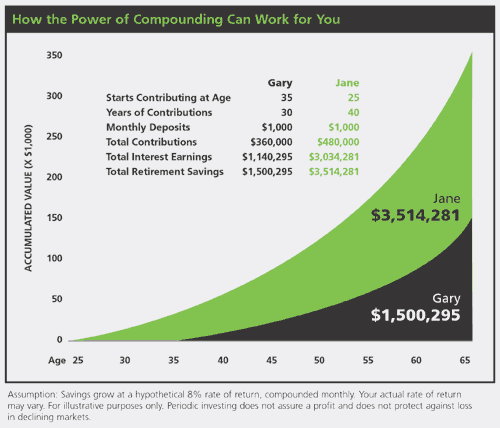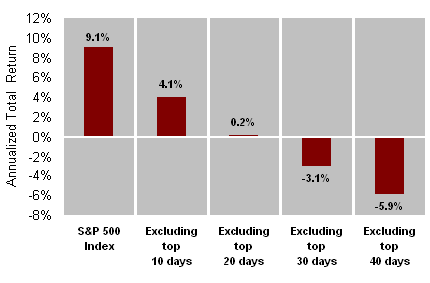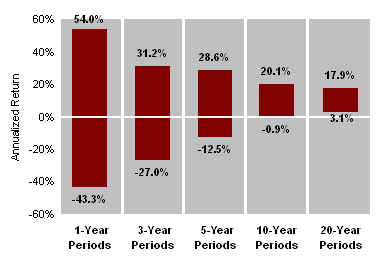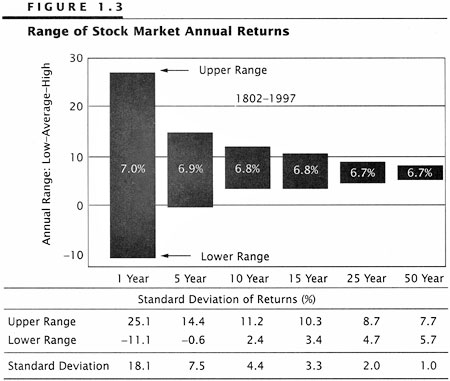7 Reasons To Invest For The Long Term, Source: The Digerati Life (www.thedigeratilife.com)
7 Reasons To Invest For The Long Term
Source: The Digerati Life (www.thedigeratilife.com)
1 It’s easy enough for anyone to do.
Creating a diversified portfolio based on your preferred asset allocation is straightforward and can be set up right away. Even if you are a new investor just learning the ropes, you can learn quite a bit by signing up for a free brokerage account with one (or more) of these topnotch online brokers, where educational materials are freely accessible to their customers.
While some of these brokers emphasize and promote trading activity, this doesn’t mean that you can’t build a portfolio here and set it up using long term investing strategies. You can check with these online discount brokers and mutual fund companies about setting up an automatic investment plan where you contribute money on a monthly basis while having your portfolio chug along on autopilot.
Investing for the long term is not rocket science and is easy to understand. What’s really awesome about it is that you don’t need to do much at all to do really well using this strategy. Plus it takes much less effort and work than the alternatives.
Now contrast this to perfecting the “art” of short term trading and market timing: you’ll find yourself attending seminars, learning how to trade, going on margin, playing with options, needing to constantly do active work (scanning screens, paying attention to charts, prices, graphs) and studying to try to make money on a daily basis in the various markets. Not to mention staying up late and waking up early just to participate in the market action. Then there’s that little matter of potentially losing your shirt. It just seems so draining after a while.
Day trading seems like a huge pain in the arse and not everyone is built for this. I personally know a day trader who’s an expert on foreign currency trading, but he sacrifices quite a bit of time doing the work and investing on software, books and information. Don’t get me wrong — there are people perfectly BUILT for day trading. But the question is: are you one of them?
If you’re an average investor who does your investing on the side, I’m not quite convinced that all of your short term gains (which are subject to income tax and transaction fees, by the way) can ever beat the returns you get from the effects of old-fashioned long term compounding.
#2 The power of compounding is your friend.
One complaint I hear from those starting out as investors is this: it takes too long to make any money in the market. Everyone seems to want that immediate gratification and quick results. That was why the dot com era lulled so many people down the wrong path, convincing them that anything they touched was golden….on paper. Practically everything was on an uptrend, and everyone enjoyed the thrill of making quick virtual money. Unfortunately, many a portfolio did not meet with a happy ending.
If we had just all ignored how the market was behaving then, and focused on the long term, that particular boom/bust cycle wouldn’t affect us so grandly. Long term investors with their eye out into the future usually ignore current market conditions, or at least, don’t obsess over them. They may tweak their portfolios a bit, but they don’t overreact to market movements.
Our focus should be on starting an investment plan as soon as we can, and investing on a regular basis. This strategy will then allow your money to compound through the growth of reinvested earnings and a regular savings plan. You also don’t have to wait that long to see the effects of compounding: the formula, called the rule of 72, tells you how long it will take for you to double your money. Given a reasonable long term rate of return of 8%, you can expect to double your money in 9 years: 72 / 8 = 9.
Because of the power of compounding, the earlier you start investing and the longer your time horizon, the more portfolio growth you’ll be able to achieve.
 Image Source: H&R Block
Image Source: H&R Block#3 Passive investments are convenient.
You don’t have to do much with a long term portfolio. Long term investors are proactive while short term traders are reactive. A long term investing plan requires much less time to set up, manage and evaluate than any other form of investing. Plus, you’ll be far more relaxed with more time on your hands by going this route. Those who are traders pretty much play the market for a living, finding out quickly that to succeed, they’ll need discipline, nerves of steel, intestinal fortitude and emotional control. I don’t know about you, but I’d rather leave the ulcers to those adventurous folks.
#4 By staying invested, you avoid making costly mistakes.
Being an emotional investor without an eye on the long term can be potentially costly. If you tend to jump in and out of the market based on how the market is behaving, you’ll run the risk of missing out on those powerful rallies that can catch you unawares. Just take a look at this graph that shows the effects of being out of the market during strong market rallies.
From Schwab.com:
We studied portfolios to see what happens when you miss the top days in the market. Our research, looking at returns from 1996-2005 shows that missing the market’s top 10 days cut the return by more than half on a portfolio of stocks, represented by the S&P 500.
Missing a few trading days affects your returns S&P 500, 1996-2005

Image Source: Schwab.com

Image Source: Schwab.com
#5 A long term view lowers your risk.
When you’re invested for the long term, your average return becomes much more stable over time and it’s less likely that you’ll lose money. What does that mean? Studies show that as we lengthen our investment horizon, the average annual rate of return over that timeline becomes less variable.That is, the longer your time in the market, the more likely you’ll receive the long term average annual rate of return. And by knowing what type of long term return I can get out of the stock market, I’m more likely to stick to a plan that involves equities and to remain patient as I wait for the power of compounding to work its magic. I know that these returns are not 100% set in stone, but I’m taking the calculated risk anyway.
From Schwab.com again:
We studied the highest return, lowest return and average annual return of the S&P 500 over various holding periods from 1926. We found that as you move from a one-year holding period to a three-year, 10-year, and finally to a 20-year holding period, the number of negative returns experienced goes down. In fact, there’s never been a 20-year period with a negative return.
Range of S&P 500 returns, 1926-2005 Image Source: Schwab.com
Image Source: Schwab.com
 Image Source: Schwab.com
Image Source: Schwab.com
In this chart from Yahoo Finance, you can see that with longer investment horizons, the variability in rates of return diminishes.
 Image Source: Yahoo Finance
Image Source: Yahoo Finance
With the stock market, the shorter your time horizon, the more “random” your expected rate of return will be. For those who insist on “investing” for only a year or less, it would be just like taking a gamble or playing a game of chance, as this web site explains.
#6 A long term view gives you time to fix your investment mistakes.
If you were “lucky” enough to start investing very early in your life, you’ve got an advantage over everyone else: you’ve got TIME. Time to recover from any mistakes you make with your money. A bad year in the stock market can easily be neutralized by several successive good years. If your portfolio isn’t performing the way you like, you’ve got time to tweak it into something that should be solid enough to address your future financial goals.
#7 Your rate of return is boosted by stock dividends.
Dividends are great because they add to the overall value of your equity investments. They’re yet another element that can boost your rate of return, and are there to reward you as a long term investor and shareholder. I look upon dividends as a “buffer” for my investments in the sense that they help neutralize poor returns from stock price alone, while adding the icing on top of positive stock price performance.
Parting Thoughts
The typical learning curve for an investor begins when he or she gets their feet wet by placing some money in the stock market on a stock tip. I, along with many former colleagues, were in this boat sometime ago, before we found out that some discretionary income plus peer pressure and a sense of competitiveness over who can achieve the highest rate of return in the shortest amount of time can be a recipe for quick financial wipeouts. But we were young and silly then, so we can all just chuck it up to inexperience and youthful bravado.
These days, we know better. And most of us champion the prudent approach of taking a long term view towards investing as opposed to randomly playing the market when the urge strikes, although I do still have many buddies who like to time the market and feel more comfortable being invested for short periods at a time. My market timing buddies aren’t able to commit their portfolios to market forces without perpetually worrying about their money, and have thus felt more secure trying their luck with guessing when to enter the market and when to pull the trigger. So far, I’ve heard that the pay off from this strategy hasn’t been that exciting.
With all the benefits of long term investing, I still don’t quite get why anyone would prefer to day trade rather than to invest. Unless of course, they’re doing a mixture of both strategies. Though for those pursuing such a dual strategy, I’d sure love to hear which approach yields you the better returns!
Source: The Digerati Life (www.thedigeratilife.com)

Comments
Post a Comment